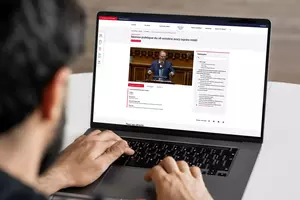B. THE RISK OF A DOCUMENT GEARED SOLELY TO NATO'S NEEDS
To quote an expression, a sort of cri de coeur , uttered during the hearings about this new Strategic Compass: NATO is Europe's compass!
As we have seen, everything is coming together for a relative disinterest in the Strategic Compass and falling in line behind a combative NATO and its future strategic concept. One symptom is that even a country like Finland, which is not a part of NATO and has long supported a stronger CSDP, no longer seems very energised by the Strategic Compass.
There seems to be a real risk of a document that mirrors NATO's Strategic Concept, starting with taking inspiration from the NATO 2030 agenda, offering nothing that could duplicate or go against its ambitions not just in military matters but in the resilience chapter as well, and whose main expectations concern deepening the 'partnership' with NATO .
Ultimately, given the systematic alignment of some Member States with US positions due to their dependence on NATO, the richness of the Strategic Compass is in the hands of the US, whose signals on the scope for a certain degree of EU autonomy will be subject to close interpretation until the end of the process. It is possible that these signals will be part of a clever effort to encourage European Allies to fully sign up to NATO's strategy, particularly towards China, while encouraging them to continue efforts on military spending.
C. THE RISK OF A MORE AMBITIOUS DOCUMENT WITH LITTLE EFFECT
Even if it is disappointing relative to France's ambitions, the final document could include interesting opportunities, especially in terms of resilience concerning contested spaces, that should be made permanent. Regarding the CSDP, the establishment of a first entry force of around 5,000 troops (see above), supported by Josep Borrell, could be seen as significant progress. This project would be a reasonable objective at the EU level and, if it is designed to avoid any significant duplications, neither NATO nor the United States could seriously take offence.
That is why it is important to ensure that, once the exercise is over, to establish a political monitoring and support mechanism , in line with one of France's main concerns (see above).
The Strategic Compass should include an implementation schedule through 2030 of the measures it contains along with a control mechanism , for example regular intergovernmental meetings to review how the operational objectives are being achieved, meetings that can be taken up by future presidencies, particularly the Czech Republic in the second half of 2022 and Sweden in the first half of 2023 (which forms the next 'trio' with France).
D. THE RISK OF A DOCUMENT THAT BECOMES A STRAITJACKET IN A CRISIS
The experience has shown that the European Union can find willpower when put to the test, but this is much less true once there is some distance. Thus, one serious pitfall would be arriving at a very formal document , particularly if it assumes a minimum capacity for action. This would make the Strategic Compass counterproductive if there is a problem. Here, we can recall the origins of the EUBGs: a Battlegroup-type operation led in 2003 was a success, before an instrument was formalised in 2006, and it has never been deployed since.
This reasoning could be extended to relations with NATO: it might be beneficial for the Compass not to set them in stone , in line with one of France's concerns (see above). According to certain observers, the EU-NATO relationship also tends to improve when it is based on action.
Similarly, no doubt it would be wise not to get into the details of what the EU's positions will be in its relationships with Russia, Turkey, China, and certain North African countries. Prejudging our positions here would entail a loss of flexibility with significant diplomatic and operational consequences.
But finding the right balance is difficult. If we are content to characterise phenomena in a general way--using notions such as interstate conflict, regional conflict, failed state, etc.--without going into enough detail, then we risk a non-operational document.







